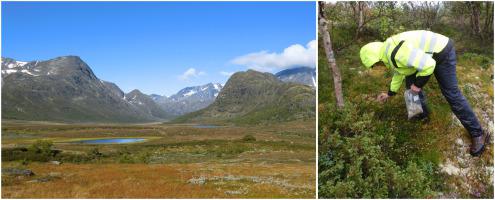Journal of Environmental Radioactivity ( IF 2.3 ) Pub Date : 2021-02-22 , DOI: 10.1016/j.jenvrad.2021.106551 Lavrans Skuterud , Håvard Thørring

|
The present study summarizes three decades of studies on 137Cs transfer to various species of lichens, graminoids, herbs and woody plants across a ~3000 km2 area used as mountain pasture for reindeer and other ruminants. The investigation comprised of field studies covering the period 2011–2016, and a compilation of studies and data for the preceding period (1986–2010). Altogether, more than 700 individual vegetation samples were considered. For lichens, relatively fast decrease in contamination levels was observed during the first decade after the Chernobyl fallout (ecological half-time of about 3 years). For later years there seems to be a continuous re-contamination which results in a “steady state” where time-trends are mainly governed by physical decay of 137Cs. For green plants, decline in transfer factors (TF) (i.e. the ratio between activity concentration in vegetation and activity density in soil) during the period 1986–2012 was not as pronounced as for lichens: Some species showed significant decrease with time, while others did not. 25–30 years after the Chernobyl accident, 137Cs levels in lichens and green plants were significantly dependent on the levels in soil (R2 between 0.53 and 0.57), but there were also some significant differences in transfer between sampling sites. Moreover, marked variability in TFs was found between different plant species growing at the same site, whereas such differences were not found for reindeer lichens.
中文翻译:

山区植物区系中的137铯着重于驯鹿的饮食-时空趋势
本研究总结了三十年的研究,涉及在约3000 km 2的面积上用作山地牧场的驯鹿和其他反刍动物的137 Cs转移到各种地衣,类动物,草药和木本植物中。该调查包括涵盖2011-2016年期间的实地研究,以及前一时期(1986-2010年)的研究和数据的汇编。总共考虑了700多个单独的植被样本。对于地衣,切尔诺贝利事故发生后的第一个十年(生态学半衰期约为3年)观察到污染水平相对较快地下降。在随后的几年中,似乎不断受到污染,导致“稳态”,其中时间趋势主要受137的物理衰减控制。CS。对于绿色植物,1986-2012年间转移因子(TF)的下降(即植被中的活动浓度与土壤中的活动密度之间的比率)不如地衣那么明显:某些物种随时间显着减少,而另一些物种则随时间显着减少。没有。切尔诺贝利事故发生后25–30年,地衣和绿色植物中137 Cs的水平显着取决于土壤中的水平(R 2在0.53至0.57之间),但采样点之间的转移也存在一些显着差异。此外,在同一地点生长的不同植物之间,TFs存在明显的变异性,而驯鹿地衣则没有这种差异。


























 京公网安备 11010802027423号
京公网安备 11010802027423号